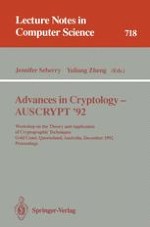This book contains the proceedings of AUSCRYPT '92, an international conference on cryptologic research held on the Gold Coast, Australia, in December 1992. This is the third conference held outside the series of CRYPTO meetings held in Santa Barbara, California, each August and EUROCRYPT meetings held in European countries each northern spring. The first two were AUSCRYPT '90, held in Australia, and ASIACRYPT '91, held in Japan. The volume contains three invited papers and 44 contributed papers selected from 77 submissions. The articles cover all main topics in modern computer and communications security research.These include: - authentication - secret sharing - digital signatures - one-way hashing functions - design of block ciphers - cryptanalysis - cryptographic protocols - pseudo-random sequences and functions - public key cryptography.
